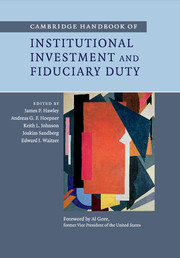Book contents
- Frontmatter
- Contents
- List of figures
- List of tables
- List of contributors
- Foreword
- 1 Introduction
- Part I Fiduciary duty: a global outlook
- Part II Fiduciary duty and the landscape of institutional investment
- Part III Challenging conventional wisdom on fiduciary duty
- Part IV Towards a broader interpretation of fiduciary duty
- Part V Beneficiaries’ roles and viewpoints
- 26 The voice of the beneficiary
- 27 Understanding the attitudes of beneficiaries: should fiduciary duty include social, ethical and environmental concerns?
- 28 Operationalizing socially responsible investment: a nonfinancial fiduciary duty problem
- 29 The preferences of beneficiaries: what can we learn from research on retail investors?
- Part VI Fiduciary duty and governance
- Index
- References
26 - The voice of the beneficiary
Published online by Cambridge University Press: 05 April 2014
- Frontmatter
- Contents
- List of figures
- List of tables
- List of contributors
- Foreword
- 1 Introduction
- Part I Fiduciary duty: a global outlook
- Part II Fiduciary duty and the landscape of institutional investment
- Part III Challenging conventional wisdom on fiduciary duty
- Part IV Towards a broader interpretation of fiduciary duty
- Part V Beneficiaries’ roles and viewpoints
- 26 The voice of the beneficiary
- 27 Understanding the attitudes of beneficiaries: should fiduciary duty include social, ethical and environmental concerns?
- 28 Operationalizing socially responsible investment: a nonfinancial fiduciary duty problem
- 29 The preferences of beneficiaries: what can we learn from research on retail investors?
- Part VI Fiduciary duty and governance
- Index
- References
Summary
Introduction
This chapter outlines the case for pension fund beneficiaries to have a greater say in investment policy – both proactively, by having their views taken into account in the formulation of policy, and reactively, by being empowered to hold fiduciaries to account for decisions made on their behalf. We address various common legal and practical objections to such involvement and explore how these play out in practice through real-world case studies. We argue that existing fiduciary law allows more scope than is often supposed for such beneficiary engagement and, moreover, for this to extend beyond purely financial matters. None the less, we conclude that there is a need for legislation both to clarify the law and to change it in certain respects.
What do we mean by “beneficiary engagement?”
It is important to be clear from the outset about what we do and do not mean by “beneficiary engagement,” since objections to the idea often appear to stem from misunderstandings and straw men. First, we are not suggesting that beneficiaries should have the right to “instruct” trustees but rather that they should have the right to be consulted and have their wishes taken into account as part of the trustees’ decision-making process. Second, we are not suggesting that trustees should be required to consult beneficiaries on the day-to-day minutiae of investment decision-making. We envisage that input from beneficiaries would relate mainly to general policy on investment and engagement rather than to “any tedious case-by-case consideration of … individual investments” (Richardson 2011a: 11). In relation to individual decisions, we see a role for retrospective transparency and accountability to beneficiaries about the decision taken and the reasons for it. Of course, this should not preclude beneficiaries from making their views known in advance where they feel particularly strongly about a particular question (see, for example, Case Study 26.4).
- Type
- Chapter
- Information
- Publisher: Cambridge University PressPrint publication year: 2014
References
- 3
- Cited by



